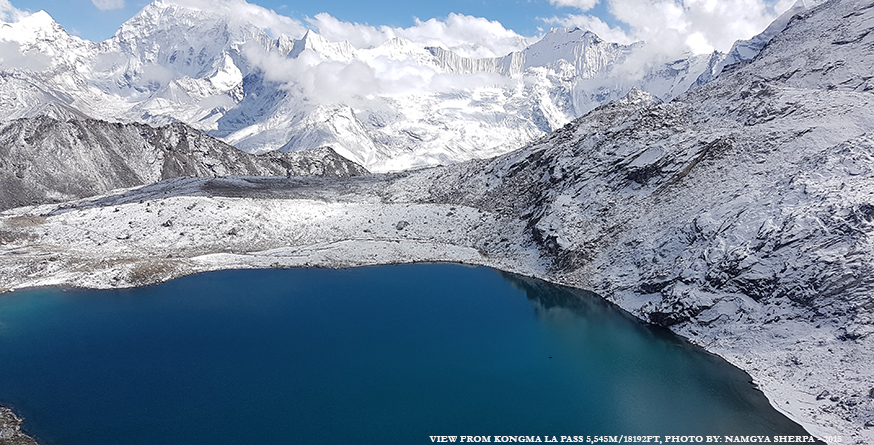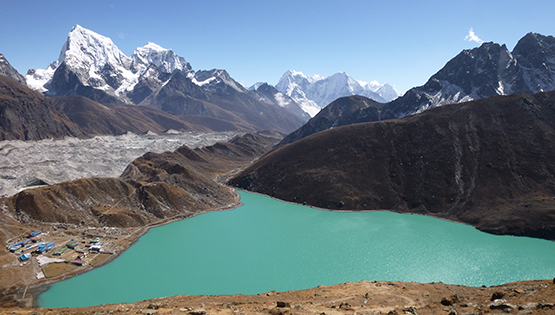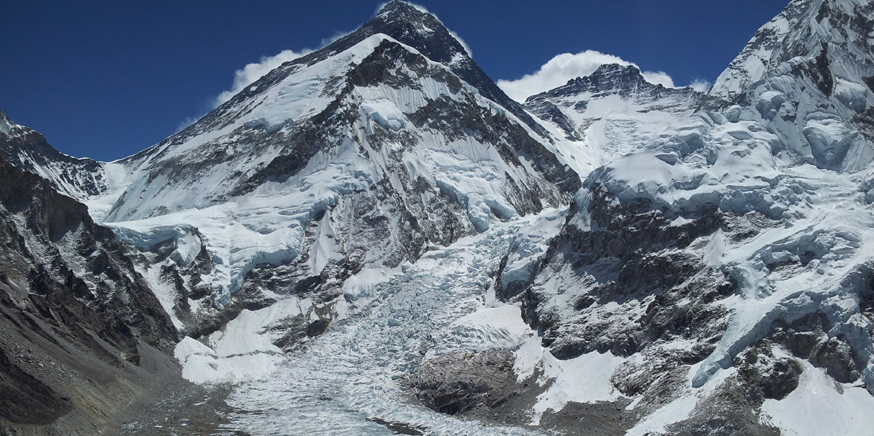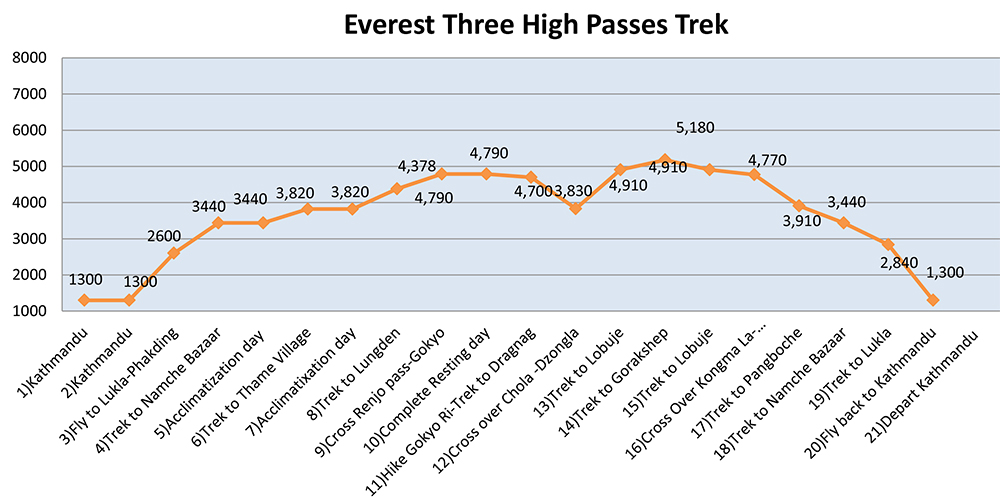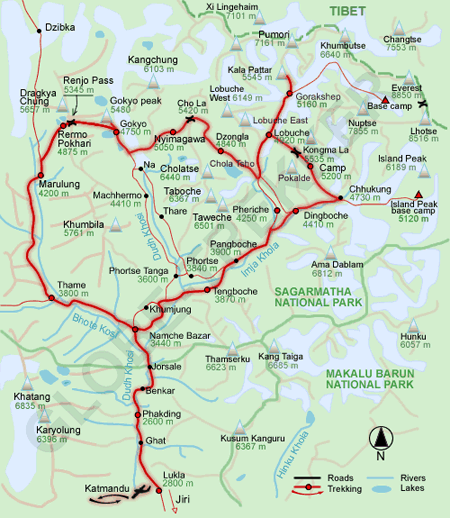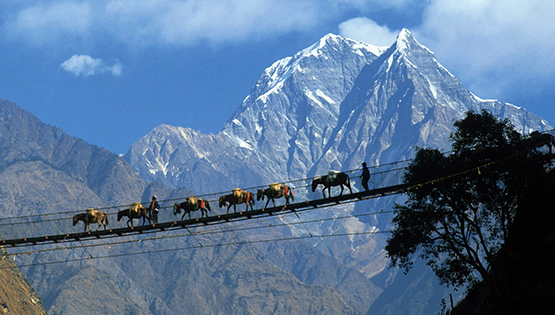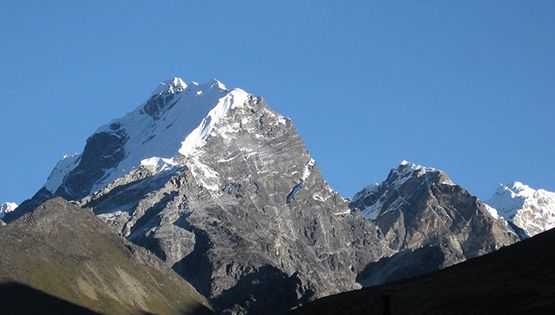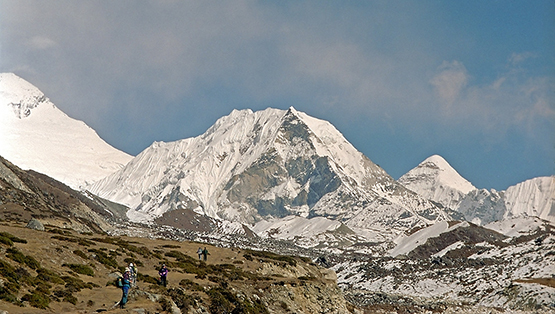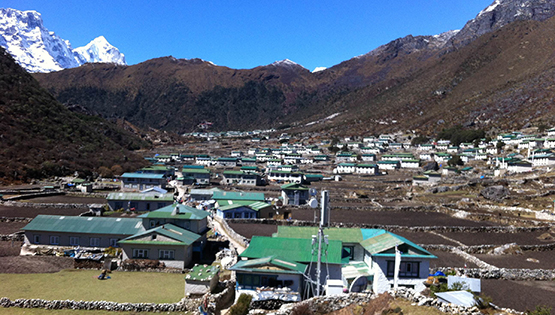Everest Three High Passes Trek (ETHPT) is arguably the most complete trek in Nepal as it covers most of the Everest region on its circular route. And it is a most admired trek in the Everest region. The views of the incredible high Himalayan peaks are awe-inspiring. The best part of the Everest three high passes trek is that it can be done both clockwise as well as anticlockwise direction. We/ Grand Himalaya have been running this trek continuously both direction and we discovered the clockwise direction offers slightly more flexibility. This trek is much challenging than any other treks in Everest region as it involves traversing the three high passes. The first and recently opened Renjo La pass 5370m,between Thame valley and Gokyo Lake/valley. The second is the well-known Cho La pass 5420m, between Gokyo valley and Everest Base Camp. The third (final) is Kongma La pass 5545m, between Everest Base Camp and village of Chhukung in Imja valley, each over 5,000m. The trek begins in the popular starting point of Lukla at 2840m elevation before heading north along the classic trek to Namche Bazaar. Here, the route veers west as it splits from the main trek and heads up the Bhote Koshi valley, where you will encounter the first of the Three Passes Renjo La. After reaching the high point, the trail descends to the idyllic Gokyo Lakes and further on to the village of Gokyo. The route then turns east as you make your way to Everest Base Camp by crossing the second pass Cho La at 5420m. After the second pass you will re-join the Everest Base Camp highway at Lobuje to explore the historical Everest Base Camp as well as soaking up some of the best views of Everest and the surrounding peaks when you climb the iconic viewpoint of Kala Patthar 5555m. The inwards leg of the trek involves traversing the final of the Three Passes Kongma La to join up with the classic Everest Base Camp Trek route that will take you down to Lukla, where the trek ends. The typical trail of trekking in Nepal that goes up and down the rolling hills so many times like the waves in an ocean. Well maintained physical fitness level to be able to walk 6-8 hours of at altitude each day, well preparation and handful of good luck on weather is required to complete this trek. However, the spectacular views of surrounding mountains located in Khumbu valley, such as Everest, Makalu, Lhotse, Cho Oyu, Pumori, Amadablam, Thamserku, Island peak, Lobuje paek, Taboche peak, Cholatse and many more peak is certainly worth at the end. Exploring such isolated corners of Himalayas is an amazing experience. There are a lot of Buddhist monasteries, Chortens and Mani walls along the Everest high passes trekking route in Khumbu that are really striking. Plus, you can see a range of floras from pine and hemlock forests at lower altitudes, fir, juniper, birch, and rhododendron woods. Trekkers can benefit from exploring the homeland of Sherpa, villages and understand its rich culture. Email us on namgyasherpa.grandhimalayatrek@gmail.com or chat on WhatsApp number +977 9841427399 for detailed trip notes. For further details please go to our Travel Tips

A very warm welcome to the Kingdom of Himalayas. Upon your arrival at the Tribhuvan international airport our representative welcomes you and assists you transfer in your hotel in Kathmandu. After time to get refreshed, evening you'll meet and transfer for welcome dinner in one of the typical Nepalese restaurant in the heart of Kathmandu i.e. Utsav or Nepali Chula (Kitchen). Here you will not simply experience the traditional Nepalese dish but will be entertained with Nepalese traditional dance and folk songs. After the dinner, you will be transferred back to your respective hotel.

Kathmandu is the historical and cultural heart of Nepal and has been a popular destination for tourists ever since Nepal opened its doors to visitors. The city presents a wonderful mix of Hinduism, Tibetan Buddhism and Western influence in the Valley. Bauddhanath: Stupa with its 130 ft. dome. One of the world's largest Stupa, Bouddha is generally acknowledged to be the most important Tibetan Buddhist monument outside Tibet. Tibetans simply call it CHORTEN CHEMPO "Great Stupa". It has now become the Mecca of Tibetan exiles in Nepal. Walking around Bouddhnath one often fins men wearing long braids wrapped around their heads. Many of these pilgrims carry their own prayer wheels, which they spin incessantly. Pupshupatinath Temple: Pashupatinath is considered one of the holiest shrines of all the Hindu temples. The temple has remained the presiding deity of ruling Nepalese Royalty. Located on the banks of the Bagmati river, this two-tiered magnificent golden temple with four triple silver doorways is unique example of the Nepalese temple architecture. It is one of the largest Hindu temple complex in' South Asia with hundreds of Shiva lingams, shrines icons of various Hindu god and goddess insides. This temple site occupies an area of 281 hectors in total. The main entrance of this temple is in the western side facing a small street of Deopatan market. As non-Hindus are not allowed to enter this temple courtyard. They are advised to go on the other side of the river in the East to have a glimpse of the temple complex. In the middle of the spring (Feb. March) every year there occurs a festival called Shivaratri. The world Shivaratri means the holy night of Lord Shiva. On this day many devotees visit the Pashupati Nath temple and make the ceremonial fire. Most of the devotees spend the night offering prayers to Shiva. This festival attracts tens of thousands of pilgrims from India besides the locals. Historically pre-Christian era this temple seems to have its origin away back to the early Kirat period. Stone sculptures found in the vicinity support the antiquity of this place. This holy site is 6 km. east oil down town Kathmandu. Regular bus and taxi services are easily available from a city points. After the city tour, our guide or the company's manager will do the full briefing of the trek. They will also take the opportunity to check the members' personal equipment as the city bazaars and climbing shops will provide the last chance to correct any deficiencies.

It's a panoramic thrill flying into Lukla in a Twin Otter plane on a clear day. The views of snow-capped mountain peaks sprawling around you outside your plane are almost ecstatic, beginning a whole chain of memorable experiences that stay with you for a long, long time. This is an exciting flight, which should give a glimpse of Everest in the distance. In Lukla, we will meet our trek staffs and porters and set off straightaway for our first night's stop at Phakding 2600m. Situated on the banks of the Dudh Kosi, which drains the whole of the Khumbu Region, this small hamlet is on the main trade route through the area and there are a number of clean, well-built lodges where we can spend the night.

We will continue up the banks of the Dudh Kosi, crossing it twice by small suspension bridges before reaching the Sagarmatha National Park. We will then cross the confluence of the Dudh Kosi and the Bhote Kosi on a high suspension bridge and climb steeply for about two hours up 'Namche Hill' to reach Namche Bazaar (3,440m/11,286ft). This is a prosperous trading town and the capital of the Khumbu Region. Many Tibetans used to cross the nearby border (Nangpa La Pass) to trade their wares and the local market is a fascinating spectacle. This is a good place to buy genuine Tibetan artefacts. Just across the valley to the east stand the peaks of Thamserku, Kusum Kanguru and Kangtega are very impressive mountains.

Namche Bazzar is the highlight of EBC trek and the heart of the Everest (Khumbu) region which has government offices, ATMs, Internet cafes, shops, restaurants, a bakery and a colourful market each Friday evening and Saturday. This is first scheduled 'acclimatization' day for this trek. Health experts always recommend us to stay active and moving during the rest day too instead of being idle. If we trek few hundred meters vertical during the day, it will help us to acclimatize with the alien heights that we are going to confront on the trek. Having been born, leading and organizing trips in the Himalayas, we believe in the natural process of acclimatization... "Climb high, sleep low". We take an interesting side trip up to Khumjung and climb up to famous airstrip at Syangboche. Just above the airstrip is the Everest View Hotel (3800m), a Japanese scheme to build a deluxe hotel with great views of the highest mountains on Earth. The Khumjung valley surrounded by the snowy peaks of Kongde and Thamserku, and the sacred peak the Khumbiyul-lha hosts a well known monastery that houses a yeti scalp. Visit Hillary School which is at the same site and spending some time in Khumjung after having lunch there, we walk back down to Namche Bazaar. Overnight in Namche Bazaar.

Thame (3,820m/12532ft) is located west of the main Khumbu Valley. It is famous as being the birthplace of Tenzing Norgay, the first person to set his foot on the summit of Mt. Everest with Edmund Hillary in 1953. Today we will take a leisurely walk towards Thame, to further aid our acclimatization, before continuing the following day up the main Everest Trail. Always stay alert and keep your eyes all around you because walking through the woods en route to Thame is largely inhabited by National bird of Nepal, Impeyan pheasant. The walk to Thame is mostly flat and gentle uphill climbs, and there are superb views of the surrounding peaks. It is a relaxing place to take another essential acclimatization day. It is not possible to continue tomorrow, as we have a large height gain to reach Lungden and we need our bodies to adjust further to the high altitude

Today soon after breakfast we will be setting off for a couple of hours of hike passing a Thame Gompa/Monastary located above the town takes 30-45 minutes, in the Himalaya views are usually clearer in the morning so we continue for the hike but we will visit the monastery in the afternoon on our way down. The Monastery is 300 years old & was established by Lama Sangwa Dorje. The main deities on display here are the most popular icons in the Khumbu: Chenresig, Guru Rimpoche and Buddha Sakyamuni. The monastery has been substantially renovated in recent years. The Thame Mani Rimdu festival is held in May. We will then relax and enjoy our rest of afternoon surroundings. There are good views of Teng Kangpoche, Thamserku, Kangtega, Kusum Kangraru and Kwangde to the south.
Trading trail continues left side of Bhote Koshi riverbank on a flat terrain to Marlung (4210m), which should not take more than 2-3hrs max. At Marlung there are two basic Tea houses good to stop for tea/Coffee break. Our long-time friend Dawa Chhiri owns a tea house “Thamserku View Lodgeâ€. After the break, we cross a small bridge over Bhote Koshi, trail becomes steady ascending and contouring along the valley to Lungden, this may take little over an hour or so. There are only 5 Tea Houses at Lungden remains operated during the peak season, advance booking of accommodation is an absolutely essential. Request your lodge owner at Thame to reserve accommodation for you the days before. We normally use Kondge View Lodge which is the first Lodge on your arrival at Lunden.
As it is going to be long & hard day, we should leave Lungden at least 6 am in the morning after breakfast, because A: it is long day B: weather patterns in the Himalaya usually remains clearer in the morning than in the afternoon to enjoy views. Approximately an hours of relatively easy ascending on slop of 30 degree angle will bring you at a picturesque ridge to allow you taking a breath, important to stay well hydrated by keep drinking water at every rest period and take some photos of the lower valley we have been walking over last few days or upper valley towards Nangpa La pass trading route, magnificent views. After this ridge trail becomes easier, kind of undulating on a grassy ground for an hour to a small lake at (4800m). If we leave Lungde at 6 am, we would be arriving at this lake by 8 am ish in a good condition and in November sun rises at this spot which will be providing us bit more pleasant for short break before we start ascending steeper slop on moraine. We are now at higher altitude, everyone will find it more difficulty on catching up breathes due thinner oxygen in air. Depending on progress everyone makes, it should not take longer than 2-3 hours max to Renjo La pass from this small lake. On approach to the pass there are nicely built stones steps, which makes easier to walk but still needs of attention if the journey is on fresh snow. The Renjo La pass (5360m) is a great vantage point to conquer. Views are unreal, with Everest and Makalu dominating the eastern panorama, far above Cholatse & Taboche that in turn dwarf Gokyo way below. The ridge is rugged and spires jut skywards. Looking across the Bhote Kosi valley are the peaks from the eastern horizons of Rolwaling. About 570 meters of descend is hard and demanding to Gokyo Lake but should not take more than 2 hours if you make relatively good progress. Overnight in Lodge
It is time to have rest day today as most of us would have found yesterday's climb pretty hard work and we have a couple more tough days ahead of us. Gokyo Lakes is a really relaxing place to stay and soak up the breath-taking scenery. It's quieter than the main Everest trail and the mountains are less enclosed. We will have a leisurely breakfast and perhaps a wander down to one of the lakes in the afternoon, or take a gentle stroll up onto the moraine at the edge of the vast Ngozumpa Glacier. However, it is important to remember that this is a rest day, so at no point should we exert ourselves too much.
The earlier the better for an ascent of Gokyo Ri in the morning particularly for the best sun rise views. It takes between two to three hours to zig-zag our way up to the summit of this famous view point. The summit boulders are draped with prayer flags and the views towards Cho Oyu the 6th highest mountain are particularly fine. We descend back down to Gokyo for breakfast, we will then continue towards Dragnag 4700m. From Gokyo Lake, we trek down the valley to the 'first lake' and then head due east across the Ngozumpa Glacier. The route across the moraine of the glacier is on mostly sandy trails that weave amongst the 'moonscape' of the glacier, before reaching the far side and the small hamlet of Dragnag (2 hours from Gokyo-3 km). We will stay in Chola Resort the new lodge in Dragnak.
This is a big day. We need to set off very early in the morning to ensure that we cross the Cho La and descend to Dzongla in good time. At first we make a very gradual ascent alongside the river up a small valley to eventually reach a sandy ridge line, which gives a great view of the Cho La ahead and to the north east. There are some impressive 6,000m peaks to be viewed from here. To the north-the rocky Nirekha Peak and Kangshung Peaks, and to the south, the icy bulk of Cholatse. We make a long, gradual descent on a pleasant grassy path to reach a lunch stop below the pass. After lunch the ground becomes more technical and it is time to pack away our trekking poles. The route weaves around boulders at first, before climbing up onto rockier ground and a final steep section to reach the top of the pass. This is on loose ground, which can often be icy, so we need to take great care and it might be that we fix a short section of rope and use crampons. Conditions on the pass can vary considerably, so we err on the safe side and bring crampons with us just in case. The top of the pass is glaciated and we walk across a flat section of snow for about 15 minutes before dropping off the side and back onto rock. With Dzongla now in sight, we pick our way down the far side of the pass and descend into a lovely valley. A stream that meanders along the bottom leads us to the lodge at Dzongla and a well-deserved rest.
The trail from Dzongla descends a little, and then contours steadily around Awi Peak, before joining the main Khumbu Valley and reaching Lobuje. There are yet more superb views today, including towards the distinctive north face of Ama Dablam. It will probably feel like something of a 'culture shock' arriving in Lobuje, as this is a busy village en route to Everest and one in which all trekking and climbing teams stay on their way to base camp. Overnight in lodge.
About three hours beyond Lobuje we reach Gorakshep, a tiny hamlet at 5,180m, which used to be the site of the 1953 Everest expedition's base camp. We'll take a tea or lunch break at Gorekshep while checking in at the hotel and then move on to Everest Base Camp. Contouring along the valley side, the trail leads on to the moraine of the Khumbu Glacier and becomes quite vague, weaving between mounds of rubble. After about 3 hours easy walk from Gorakshep, we'll eventually reach Base Camp near the foot of the Khumbu Icefall. The view of the Khumbu Ice fall from Base Camp is spectacular. This is the closest you can get to Mt. Everest without mountaineering equipment and for those visiting base camp in the spring, it is a chance to meet the Everest expedition teams from all over the world, making an ascent of the mountain. Base Camp is actually spread over quite a wide area and we will spend some time wandering through it and getting a sense of what it must be like to be camped here for two whole months, whilst attempting the mountain. To go any further than base camp, you will need to be a mountaineer! We return back to Gorakshep for the night. Overnight in Lodge
The ascent is usually demanding but after last few days of walking and crossing over two high passes above 5000m, everyone should be fairly acclimatized; and should not be difficult today. Leaving the lodge around 4am will provide the best sun rise view which is the main goal. By now it should not takes more than 2 hour to the top of Kalapatthar 5555m. . Views are magnificent mountain panorama, "Mt. Everest" the highest point on the planet at 29,028ft (8,848m), towers directly ahead and on all sides loom the other giants, Mt. Lhotse, Nuptse, Pumori, Chagtse, and countless others. We make a quick descent to Gorakshep for breakfast then continue retrace our steps back to Lobuje, rest and relax rest of the afternoon to be ready for the big day tomorrow. Overnight in Lodge.
You leave the classic base camp route today as you head east through the Khumbu Glacier to reach the third and final pass of the trip. Kongma La Pass at 5540m, ascend is tough but the spectacular views of high Himalayan peaks Makalu, Lhotse, Cho Oyu, Pumori, Amadablam, Thamserku, Island peak, Lobuje paek, Tabuche peak, Cholatse peak and additionally an amazing blue lake near the top of Kongma la is beautiful. There are no teahouses on the trail today at all, therefore everyone should carry enough supplies of drinking water and snacks estimating for 7-8hrs. 775 meters of big descend into the Chukkung Valley and eventually to the village of Chukkung where you will stay in the lodge overnight.
After a big day of crossing Kongmal La pass the day before, today is an option for those whoever have spare energy to hike up to Chhukung Ri 5548m, otherwise take a pleasure day walk down to Pangpoche through Dingboche and Somare village and visit the oldest Monastery at Pangboche in the evening before dinner. There will be no extra view to capture from Chhukung Ri anyway as we witnessed all surrounded scenery from Kongma La pass the day before.
Depart Pangboche village cross the Imja River before climbing to the monastery at Thyangboche. Here we will no doubt take advantage of enjoyment of picturesque place, as well as spending some time exploring the famous monastery. A circuit of the monastery, with its many prayer wheels is not to be missed, as is an exploration of the inside. From Thyangboche, a steep descent of around 1500ft/500m leads through bird filled rhododendron bushes and fir trees to the Dudh Kosi River at Phunki Tenga (3250m) where we will be stopping for lunch by the river. After lunch we will be crossing the river on a wide suspension bridge, the path climbs relentlessly up. En route are the lodges and lunch stops of lower Teshinga. The path again climbs on and around to Sanasa (3700m), where the route divides for Khumjung and Namche. Take the left fork here for 5 minutes to Kyangjuma (3,550m). The trail climbs and contours around endless corners. Shortly before Namche Bazaar, a new memorial stupa is found on one of these corners. This was built to commemorate the 50th anniversary of the first ascent of Mount Everest. Finally the path contours around just a little more, before reaching a crest by the Sherpa museum at Namche Bazaar (3440m). Overnight in Lodge
A steep descent for 600m/2,000ft down Namche Hill leads to the suspension bridge crossing the Dudh Kosi River and the small village of Jorsalle and Monjo (2,835m/9,300ft). The trail now flattens out and we cross the river twice more before a rising traverse up the hill-side, past numerous tea-houses to Lukla. Our last day of steady trekking will be a real joy as at lower altitudes, with two weeks behind us, and nothing left to prove, we can soak up the atmosphere in each of the villages we amble through. All excess energy is guaranteed to be exhausted at our party this evening with our Nepalese crew. Overnight in Lodge.

Saying final goodbye to our porters, we fly back to Kathmandu after our long mountain journey. The flight time to Kathmandu are scheduled in the morning normally because Lukla suffers a lot of wind afternoon. Sometime the flight time can be delayed due to bad weather and other reasons. The early morning flight drops us at Kathmandu and the Grand Himalaya van or coach will transfer you to the hotel. You may have time to relax after long journey and take back your breath and rest at your hotel with ending your Himalayan expedition. Remember, we will be hosting a fantastic celebration dinner together in the finest restaurant in Thamel, in occasion of successfully completing your trip in the Himalayas! Overnight in Hotel

Rest and relax at the hotel after such long a wonderful trip. The day is also reserved as a contingency day due to flight delays or other unforeseen conditions. For those eager to see as much of Kathmandu as possible, an early start is worthwhile to visit the temples of Pashupatinath and Swayambhunath and districts of Bhaktapur and Patan. Durbar Square is also on the essential list, as is the shopping area of Thamel. In the evening you can have your last night in Nepal, enjoying the Nepali cultural dinner show or go out to Thamel.

Today is free or last minute shopping for souvenirs or gift to your family, friends or relatives for you until your departure flight/drive or to commence any extra trips or activities you may have booked with us. If departing, you'll be transferred to the International Airport for your departure flight to your onwards destination.
- Trekking permits, conservation/National Park fees and all government taxes.
- 4 night hotel accommodation in Kathmandu in a 4 star category hotel. Accommodation is on twin share basis. Breakfast is included.
- Half day guided city sightseeing tour in Kathmandu with tour guide & transportation, (Largest Buddhist Stupa in the world at Bouddha-nath, most important Hindu temple in the valley at Pashupati-nath.
- Return Domestic flight ticket Kathmandu-Lukla-Kathmandu in a Twin Otter flight (All guests and a local Sherpa Guide). Please be advised, an extra cost of US$500-800/- per guest/direction will be applicable for chartering a private Helicopter flight in case of bad weather disturbance on fixed wing Twin Otter flight IN/OUT of Lukla.
- Domestic airport taxes.
- All pick up & drop transportation from airport to airport both domestic & international.
- An experienced Sherpa guide who knows the area, local people, culture and mountains very well.
- Assistant guide/Sherpa (4 trekkers = 1 assistant guide).
- Porters ratios: 1 porter between two guest, each team member's duffel bags weight shouldn't exceed more than 16 kg.
- Meal 3 times a day, Breakfast/ Lunch/Dinner (tea/coffee/hot drinks on the trek).
- All local staff & porters are properly insured & well equipped.
- A Oxygen, mask & regulator set (only for emergency use).
- First Aid kit only for local crews.
- Cultural celebration meal in a well known restaurant after the trek with the guide.
- International & home country domestic airfares, transfers en route & excess baggage.
- Your personal insurances. Medical, Mountain rescue & repatriation cover is obligatory.
- Personal expenses e.g. phone calls, laundry, alcoholic beverage, bottled water, Wi - Fi Internet, any electronic device charging fee in tea houses.
- Main meals (Lunch & Dinner) in Kathmandu apart from celebration meal in KTM after the trek, (Allow up to USD15-20 per meal)
- Your Nepal entry visa fee (USD $50 available on entry) Valid for 30 days.
- Tipping to the guide & local staff ($350 per guest minimum)
- Excess baggage above 16 kg will be extra charged of US $2 per kg/day by.
- Extra night accommodation in Kathmandu because of early arrival, late departure, early return from mountain (due to any reason) than the scheduled itinerary.
- Personal Trekking gear
- All our guests are kindly requested to bring your own First Aid Kit with sufficient supplies according to the prescription given by your private Doctor for the trip.
We have been running treks & expeditions within Nepal at altitude for over two decades and have realized that the having couple of an extra acclimatization days on itinerary during the trek is most essential which certainly allows all our team members to complete the trek safely, successfully and comfortably. Therefore we have added 3 acclimatization days on this trek as the trek involves walking at high altitude for most of the time. And on each of our trips to Everest region, we have added an extra contingency day as per possible delaying domestic flights in & out of Lukla. That is why "Everest Three High Passes" trek itinerary required 22 days. We understand that it is difficult for most people to get such long vacation from work but it is only way we can prevent participants from altitude sickness and to allow everyone to enjoy the holiday without any pressure of various factor.
All participants need to have travel insurance which covers medical expenses, emergency evacuation and repatriation.
Please ensure that your chosen policy provides cover for the activities, trekking with guide in remote places which you will travel in Nepal, to elevations up to (Altitude 5,555m/18,188ft) above sea level).
(111.9 miles/180km) The three passes trek is rated “Challenging”. It is a very serious adventure given its high pass crossings. It is more challenging than its sibling treks Everest Base Camp and Gokyo Lakes, but not quite as challenging as trekking peaks such as Island Peak and Lobuje Peak. However remember nothing is impossible. All you need is bit of time for physical fitness prep and the most important thing is to prepared mentally.
Our top priority will be on preventing any major issues arises during the trip which desperately requires emergency evacuation and hospitalization, we will do our best practice to bring our valuable guests to the nearest hospital as early as possible. Fastest evacuation from the remote places in the Himalaya will be in a chartered helicopters and the costs are extremely expensive which is why we recommend all our participants to have an adequate insurance which covers evacuation & hospitalization cost.
Most of the tea houses do have western-style flushing toilets. But in higher elevation, you may also find the traditional type of toilet made of either a ceramic basin on the ground or few planks precariously positioned over a hole in the ground and it is situated outside the room.
You will get the facilities of hot/cold water running with attached bathroom up-to Namche without any extra charges. But above Namche, you will be charged about USD 5$ per shower (depending upon guesthouse) for a hot water shower.
There will be a laundry facility in Kathmandu and Namche, however once we are above Namche all the facilities are going to be pretty basic and limited.
The maximum weight limit for the Lukla flight is 15kgs, which is equivalent to 33 pounds including your hand-carry (daypack). If your baggage exceeds the weight limits, additional costs of USD 1$ -2$ per kg will be applicable and the payment should be made at the airport counter itself in cash. They don’t accept cards at all.
Depending on when you plan to travel it's important to have the proper clothes and be prepared for unexpected weather. Fairly well-worn hiking boots/shoes are a must! For tours between November and the first two weeks of March bring a jacket suitable for -10 degrees Celsius. For tours at other times please bring a jacket suitable for -3 to 5 degrees Celsius, Otherwise, the daytime weather will tend to be warm or pleasant.
Duffel bag is large bag in which you will need to pack your trek gears and this will be carried by our dedicated porter during the day, weight limit in this duffels bag should not be exceeded more than 15 kg.
A sleeping bag is necessary during the trekking days and if you have your own sleeping bag, you can bring it. Otherwise, Grand Himalaya will be arranging the sleeping bag during the trek (-10 to-15 degree) at an additional cost of US$ 8/day/ per sleeping bag on request, let us know in advance.
The cost of our trip is based on a twin-sharing basis so there will be two people accommodated in each room for the duration of the tour. If you prefer private accommodation or you are a solo traveller, you'll find the option for "single supplement". Additional USD 250 for the Standard package and USD 350 for the Luxurious package will be applicable as a Single Supplementary Charge for the single room during the trip.
Most teahouses (lodges) in Everest region trails cook a delicious range of mostly vegetarian fare. Pasta, noodles, potatoes, eggs, daal Bhat (rice and lentils), bread, soup, fresh vegetables (variety depends on the season) and even some desserts like apple pies, pancakes, and some interesting attempts at custard. You will find a lot of garlic on the menu because it assists with acclimatization – eat some every day. In many villages, you may find some meat items on the menu, however we have experienced from the past seasons that many trekkers get sick after eating meat items because there is no proper refrigerator system on this trek, better you ask your guide where would be appropriate place to choose meat items. He will tell you. You can always get hot chocolate, tea, and hot lemon drinks, as well as soft drinks.
These facilities will be available in most of the places in your hotel reception by paying some service charges (US$3-$5/hour basis). Remember to bring TWO and THREE pin travel adapters! You can also buy the adapters in the supermarkets or electronic shops in the Kathmandu. Our guide can help you with it.
There will be 1 porter between two team members, so you are allowed to pack your Duffel bag with maximum of 15 kg weight for the porters. You will be carrying necessary clothing for the day, 2 liters of water, camera with spare batteries, trail snacks etc in your day pack.
No, tap water is not safe to drink or brush in Kathmandu or on the trek, we will be providing all team members with 3 liters of proper boiled water each day. Or you can buy bottled water along the trail which is safer. Or you can bring micro electrolyte water filter or water purification tablets sufficient for trek to save some extra expenses.
| # | Start Date | End Date | Trip Cost | Availability | Booking |
|---|---|---|---|---|---|
| 1 | 03 APR 2025 | 24 APR 2025 | US$3500 PER PERSON | Available | Book Now |
| 2 | 7 APR 2025 | 28 APR 2025 | US$3500 PER PERSON | Available | Book Now |
| 3 | 24 APR 2025 | 15 MAY 2025 | US$3500 PER PERSON | Available | Book Now |
| 4 | 02 OCT 2025 | 23 OCT 2025 | UD$3500 PER PERSON | Available | Book Now |
| 5 | 28 SEP 2025 | 19 OCT 2025 | US$3500 PER PERSON | Available | Book Now |
